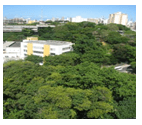
Text interpretation, “Atlantic Forest”, aimed at 1st year high school students. The text is part of the website of the important non-governmental organization “SOS Mata Atlântica”.
Download this Portuguese activity in an editable Word template, ready to print in PDF, as well as the completed activity.
Download this text interpretation activity at:
SCHOOL: DATE:
PROF: CLASS:
NAME:
Read:
The Atlantic Forest covered an area equivalent to 1,315,460 km2 and originally extended over 17 States (Rio Grande do Sul, Santa Catarina, Paraná, São Paulo, Goiás, Mato Grosso do Sul, Rio de Janeiro, Minas Gerais, Espírito Santo, Bahia, Alagoas, Sergipe, Paraíba, Pernambuco, Rio Grande do Norte, Ceará and Piauí).
Today, there are 8.5% of forest remnants above 100 hectares of what originally existed. Adding all the native forest fragments above 3 hectares, we currently have 12.5%.
This forest is a global hotspot, that is, one of the richest areas in biodiversity and most threatened in the planet and also decreed a Biosphere Reserve by Unesco and National Heritage, in the Federal Constitution of 1988. The original composition of the Atlantic Forest is a mosaic of vegetation defined as dense, open and mixed rainforests; deciduous and semideciduous seasonal forests; altitude fields, mangroves and sandbanks.
Almost 72% of the Brazilian population currently lives in the Atlantic Forest, based on estimates by the Brazilian Institute of Geography and Statistics in 2014. There are more than 145 million inhabitants in 3,429 municipalities, which correspond to 61% of those in Brazil. Of these, 2,481 municipalities have all of their territories in the biome and a further 948 municipalities are partially included, according to data extracted from the IBGE municipal grid (2010).
The Atlantic Forest Law Project, which regulates the use and exploitation of its forest remnants and resources for 14 years in the National Congress and was finally sanctioned by President Lula in December 2006.
Brazil already has more than 1,100 recognized RPPNs, more than 760 of which are in the Atlantic Forest. Of the 633 species of animals threatened with extinction in Brazil, 383 occur in the Atlantic Forest.
Available in: https://www.sosma.org.br/nossa-causa/a-mata-atlantica
Question 1 - Read the following statements about the text:
I. The territorial dimension of the Atlantic Forest is presented.
II. The Atlantic Forest is portrayed through numbers.
III. More than half of the animal species, threatened with extinction in Brazil, live in the Atlantic Forest.
Only what is stated in:
there
b) II
c) I and II
d) I, II and III
Question 2 - List:
Text passages:
Justifications for using the comma:
____ Before gerund.
____ Insertion of explanation.
____ Reversing the order of terms.
____ Adverbial expression isolation
____ Enumeration of elements.
Question 3 - Watch:
“This forest is a global hotspot, i.e, one of the richest areas in biodiversity and most threatened on the planet […]”.
The connective expression "that is" in this excerpt signals a:
a) adversity.
b) compliance.
c) explanation.
d) conclusion.
By Denyse Lage Fonseca – Graduated in Languages and specialist in distance education.
At answers are in the link above the header.
 report this ad
report this ad

